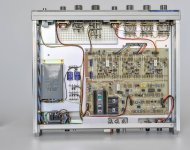Cute. . . it just keeps getting better.
I think I'm going to stop here. Time to do the real thing.
Besides ever time I post something it has a different op amp in it.
Cheers,
One of the interests i have since playing with a range of oscillators and distortion analyzers is to compare their results starting at -100dBr and below. Check for harmonic level accuracy and consistancy.
My Audio-Precision 2722 just showed up and I have to order some special interface cables to be compatible with the my new PC i7/WIN8 and software etc to get it going. I'll have some surplus distortion equipment to unload now.
Thx-RNMarsh
Can you take the lid off and tell us what's inside?
The lid is sealed by calibration stickers
I know I was kind of joking but it would be nice.
One of the interests i have since playing with a range of oscillators and distortion analyzers is to compare their results starting at -100dBr and below. Check for harmonic level accuracy and consistancy.
My Audio-Precision 2722 just showed up and I have to order some special interface cables to be compatible with the my new PC i7/WIN8 and software etc to get it going. I'll have some surplus distortion equipment to unload now.
Thx-RNMarsh
They've got some nice macros written in APBasic which you can download from Audio Precision : High Performance Audio Analyzer & Audio Test Instruments. The Impedance macro nulls the effect of cables complex Z.
It's probably time for AP to spend some time and money on a new GUI.
AS far as I have been able to determine, the ShibaSoku analyzer is a NIST/standards lab instrument compared to everything else..... including the A-Prec. It does not rely on a ADC IC as its basic instrument for measuring. The ShibaSoku design method/concept is made by all the other Japanses makers of distortion equipment for industry with added features and lower resolution for production and R&D use... such as National and Panasonic industrial test equipment.
The ShibaSoku is the size and weight of the A-P 2722 and is also packed full with circuitry..... however, the ShibaSoku does only one test -- harmonics. But it does it really, really well.
The A-P does a lot of other tests in the same space and this unit i have, A-P told me it has a $4720 option in it - A Dolby generator of some sort. ??
Between the 2 analyzers, i should be able to fairly well characterize the 99 percenters as to accuracy below -90-100dB and what harmonic data changes happen with level etc.
Thx-RNMarsh
The ShibaSoku is the size and weight of the A-P 2722 and is also packed full with circuitry..... however, the ShibaSoku does only one test -- harmonics. But it does it really, really well.
The A-P does a lot of other tests in the same space and this unit i have, A-P told me it has a $4720 option in it - A Dolby generator of some sort. ??
Between the 2 analyzers, i should be able to fairly well characterize the 99 percenters as to accuracy below -90-100dB and what harmonic data changes happen with level etc.
Thx-RNMarsh
Last edited:
AS far as I have been able to determine, the ShibaSoku analyzer is a NIST/standards lab instrument compared to everything else.
Thx-RNMarsh
My feelings as well. For day to day work with audio on a bench something like the Boonton or HP gets results very fast and is great for troubleshooting. The AP is wonderful for creating charts and graphs with automation and production line testing. The Shibasoku is more like a primary calibration standard. Its really good at what it does. Richard's newer one has the improved filters so it can be used with DAC's and really determine the performance floor. But its really a research instrument and assault on the state of the art of pure analog design.
I don't think it will be on the for sale list from what he wrote. . .
Can you take the lid off and tell us what's inside?
Actually, yes..... I will have to open it up to install the new option kit (IMD) on order. Then, I can take pictures for everyone.
-RM
Ap thread
Here you go guys. A dedicated thread for Audio Precision.
http://www.diyaudio.com/forums/equi...precision-ap-analyser-series.html#post3582673
Here you go guys. A dedicated thread for Audio Precision.
http://www.diyaudio.com/forums/equi...precision-ap-analyser-series.html#post3582673
I would hope that with the 15/16 connected to the 725 via GPIB that when the oscillator level or freq were changed, the 725 analyzer would respond accordingly. OR is the GPIB there to interface with a PC to control and gather data and Not be connected directly to each other. ??
And, then we have APIB. Why didnt A-P stay with GPIB? Is the APIB a stripped down GPIB or what? I guess the APIB/GPIB was put there for a factory automated test station/system and be a way to connect to other brands (TEK, HP, etc). For low volume use, the APIB/hardware/software doesnt seem worth the effort to use it.
THx-RNMarsh
And, then we have APIB. Why didnt A-P stay with GPIB? Is the APIB a stripped down GPIB or what? I guess the APIB/GPIB was put there for a factory automated test station/system and be a way to connect to other brands (TEK, HP, etc). For low volume use, the APIB/hardware/software doesnt seem worth the effort to use it.
THx-RNMarsh
Last edited:
It looks as though the Shibasoku uses an analog multiplier as the AGC element. Both the AG15 state variable oscillator and the 590AR Wein bridge seem to use the MC1495L analog multiplier http://www.onsemi.com/pub_link/Collateral/MC1495-D.PDF . The part is socketed so selection is probably a key part of the process. They get exceptional performance with pretty conventional parts.
- Home
- Design & Build
- Equipment & Tools
- Low-distortion Audio-range Oscillator
